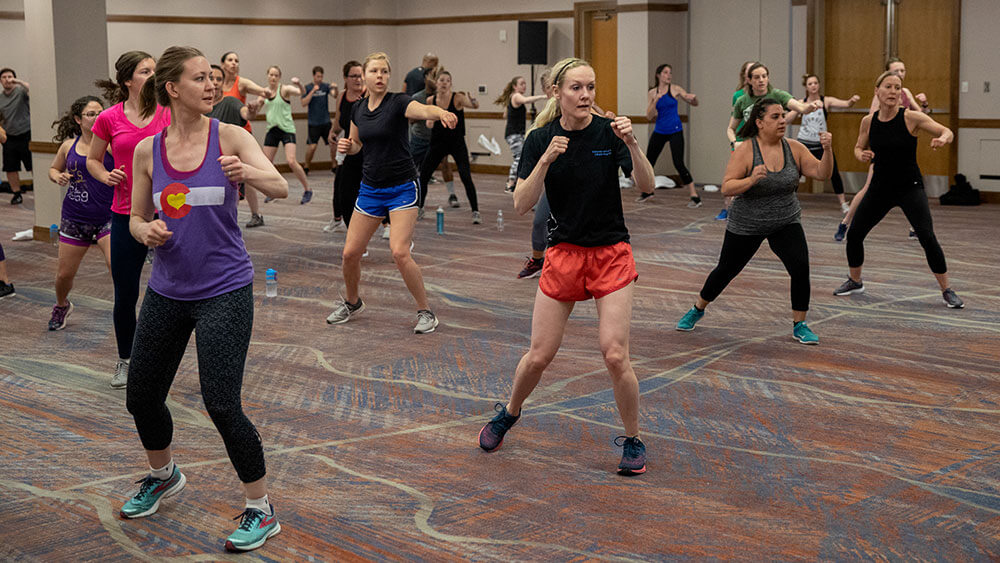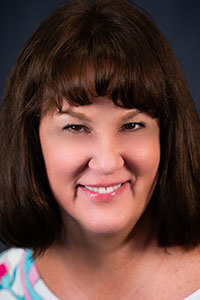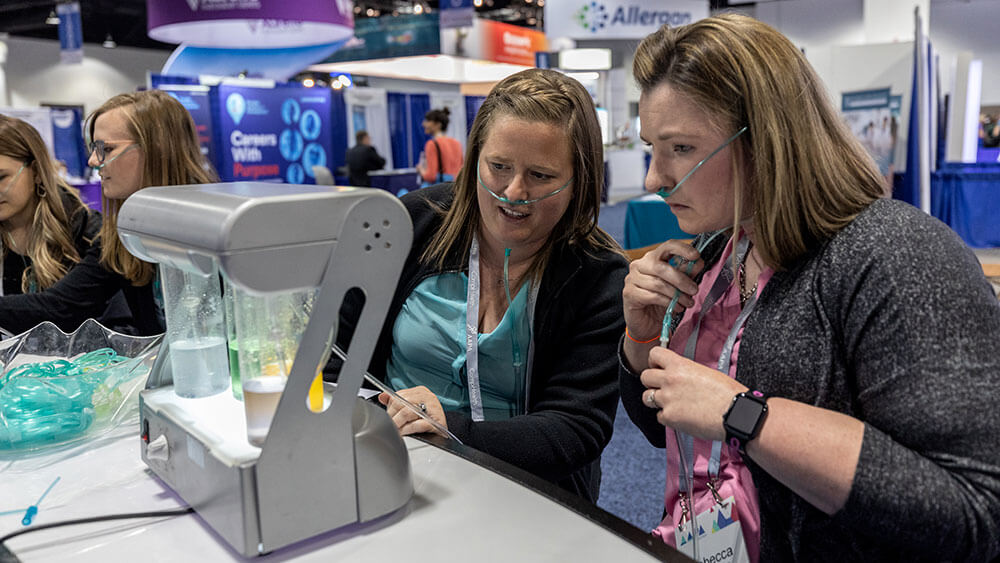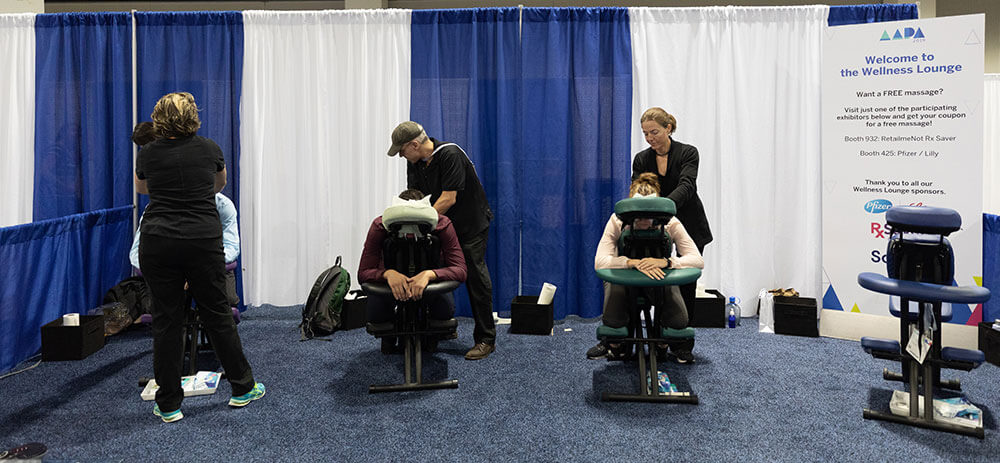
Attendees at the 2019 annual conference of American Academy of Physician Assistants take advantage of one of the offerings: a workout class. (Photos courtesy AAPA)
Burnout. Stress. Anxiety. Exhaustion. They’re issues that people in every industry report suffering from, but for those in the medical field, they can be especially severe.
“Our attendees are cancer nurses,” said Jen Krause, the Oncology Nursing Society’s (ONS) director of national conferences and meetings. “They work long hours. They’re in high-stress situations. They’re administering medication that can truly be life-or-death. A lot of them suffer burnout and compassion fatigue.”
Karen Bradley Burnett, CEM, senior director of conference and meetings for the American Academy of Physician Assistants (AAPA), reports similar struggles among her membership. “They take care of everybody else but then they don’t take care of themselves,” she said. “It’s a problem in the medical profession.”
So where do annual meetings fit in among all that stress and burnout? Between travel, long days, and pressure to squeeze in enough CME credits, it’s easy for conferences to become fresh sources of anxiety and exhaustion rather than reprieves from the daily grind.
But it doesn’t have to be that way. In the last few years, planners have been working to infuse wellness into their meetings, right alongside the usual networking and education. “Provider wellness is a new term in the profession and a new focus, so we decided to provide more of it at our conference,” Burnett said. So did Krause, and so have a growing number of other health-care meeting organizers. Here’s how they’re doing it and what they’ve learned in the process.
Making Mindful Spaces
After experiencing mindfulness coach Lee Papa’s meditation sessions while attending one of Experient’s e4 conferences, Burnett knew she wanted to book Papa for the AAPA’s annual conference.
At the 2019 meeting in Denver, May 18–22, Burnett set up a dedicated “mindfulness lounge,” where Papa led eight guided meditation sessions a day for three full days. The meditations lasted 20 minutes each, which meant attendees could easily fit them into their schedules.
“It was wildly successful,” Burnett said. “I told [Papa] before the end of the conference, ‘Now you’ve become a permanent feature.’” Burnett is already planning to bring the mindfulness coach back this year, allowing attendees to develop long-term relationships with their new meditation leader.

Laura Jelinek
The American Osteopathic Association (AOA) has also been upping the wellness elements woven throughout its annual meeting, OMED. At the 2018 conference, Laura Jelinek, CAE, AOA’s associate vice president of meetings and travel, took advantage of the San Diego weather and set up an outdoor meditation area with yoga blankets and pillows, open to attendees all day, every day. For 2019, held Oct. 16–19 in Baltimore, she kicked it up a notch with a dedicated meditation room and guided sessions.
Jelinek said the key to prioritizing these types of offerings is giving attendees enough time to enjoy them. “We all tend to overschedule our attendees,” she said. “Give them a chance for downtime, where they can seek out calmness on their own or even just have lunch with a friend.”
Tapping into Wellness Design
A wellness design movement is sweeping through the architecture and design worlds right now, justas the green building movement did before it. But where sustainable design focuses on preserving the planet’s health, wellness design is all about us — the air we inhale, the light we see by, the sounds we hear. “The trends we’re seeing in wellness design overlap with anybody in the planning business,” said Susie Frazier. Frazier is an Emmy Award-winning artist and author who helps meeting planners and corporations design spaces for wellness, and works with Destination Cleveland to incorporate wellness concepts in their approach.
Drawing on the hallmarks of wellness design, she encourages planners to set up “alternative settings” whenever possible — for instance, holding breakout sessions in small, living-room-like spaces with plush furniture, coffee tables, and soft lamp lighting.
“Find little places where people can feel cozy and hang out at every turn,” she said. That could even mean trying an unexpected location for an off-site event at your next meeting, like an art gallery or a farm. “Creating a unique experience through the setting and the way that the environment is designed can really change people’s outlook on why they would attend an event in the first place,” Frazier said. She also recommends including photos of the different environments that attendees can expect to experience in any promotional materials — “really lure them,” she said, “with those visuals.”
Wellness design also recognizes the role of sound. “Our society has become so desensitized to the barrage of noise that we all live with,” Frazier said. “We really need to be paying attention to the sound we’re subjecting people to.” She doesn’t advocate silence, but rather a single source of sound. Ideally music that is “ambient and rhythmic, with a continuous flow,” she said. And if you need to have videos running, press that mute but- ton and turn on closed captions instead.

Oxygen bars were among the wellness offerings at the 2019 annual conference of American Academy of Physician Assistants.
Getting People Moving
The AAPA introduced morning fitness classes at its 2018 conference, and the sessions proved so popular that Burnett wanted to up the ante for the 2019 meeting, which she’d already decided would have a greater emphasis on wellness.
For the 2019 conference, Burnett scheduled fitness classes on four mornings of the meeting, and on the fifth day, offered a 5K fun run/walk fundraiser. She said the daily free classes, which began at 6 a.m., were filled to capacity every day.
The lineup included cardio kickboxing, a Pilates-yoga blend called PiYo, and a boot camp. An AAPA member who is also a trained fitness instructor led the sessions — something Burnett said brought a unique “peer-to-peer” element to the classes.
Yoga and 5K fun runs have become staples at many other medical meetings, too, including the ONS Congress and the AOA’s OMED.
Jelinek said the key with any fitness program is making sure it’s accessible to anyone — which is why OMED’s daily morning yoga is designed to be equally welcoming of first-timers as well as more skilled yogis.

In addition to workouts and an oxygen bar, AAPA attendees could get onsite massages as part of the event’s wellness focus.
Using the Hall
With wellness top of mind, a number of conferences have begun carving out destinations devoted to that pursuit within their exhibit halls.
At its 2019 congress, held April 11–14, ONS debuted a “wellness pavilion” in its hall at the Anaheim Convention Center with the theme “caring for the caregiver.” The area included poster sessions focused on topics like compassion fatigue and self-care, along with a Sephora booth that offered mini skincare and makeup services and provided information about the store’s Brave Beauty in the Face of Cancer Classes for oncology nurses to share with their patients.
But Krause said it was the puppies that sparked the most excitement. She connected with a local therapy dog group and arranged for canines to come in shifts anytime the exhibit hall was open. “We’ll probably never not have puppies at our show again,” Krause said. “Our members aren’t often on Twitter, but we saw tweet after tweet about the puppies.”
For a conference whose sessions often focus on heavy topics — and whose members deal with death on a daily basis — Krause said going into an exhibit hall to cuddle puppies was the perfect antidote. It also drew larger crowds to the hall “because puppies and Sephora were there.”
The AOA tapped into the power of pets, too. At OMED 2018 in San Diego, Jelinek and her team linked up with a local shelter to bring dogs and cats into a custom-built “Cuddle Station” inside the exhibit hall, because it’s “such a great way [for attendees] to relieve stress,” she said. As an added bonus, one dog even found a “forever” home with one of Jelinek’s attendees.
The AAPA also introduced a “wellness center” booth in its exhibit hall for 2019. Inside, attendees could visit an oxygen bar — due to that year’s location in the “Mile High City” — or get a chair massage. Burnett kept lines under control and drove traffic to exhibitors by requiring attendees to visit specific booths for their massage tickets. She’s planning to increase the wellness center’s footprint in the 2020 hall — and bring back those massage chairs, too.
Seeking Out Nature
Research has continuously found strong connections between wellness and access to nature. With that in mind, Frazier recommends getting attendees outside in any way possible.
It doesn’t have to be the peak of a mountain or the middle of a redwood forest to work. A local park, a beach, or even an “urban walk” looking for patterns in sidewalks or weeds growing between buildings can all do the trick, Frazier said. She suggests booking a local plant expert to lead the excursion — someone who can tell people more about everything they’re seeing.
“The key is making it fun,” Frazier said. That might mean asking attendees to bring back bits of what they find outside for an art-making exercise. Or it could become a contest that ties in social media. “Something people can sink their teeth into,” she added.
It can even be as simple as moving your existing offerings outdoors, weather permitting. ONS has held a group yoga session at its annual congress for the last few years, but in 2019, they were able to take their yoga outside in the Southern California sunshine. “It was beautiful,” Krause said, “especially compared to doing it inside a convention center.”
Eating Healthy and Light
When the Renal Physicians Association (RPA) welcomed a new president in 2017, they also embraced his preference for a plant-based diet. Now Desiree Bryant, CMP, RPA’s director of meetings, has been placing orders for quinoa bowls, fresh fruit, and almond milk — and scaling back on doughy bagels and heavy sweet breads on the breakfast buffet.
Bryant has lightened up the snack options, too. During breaks, attendees can sip smoothies or green juices and crunch on vegetables with hummus — or opt for the more traditional bags of chips and popcorn.
“I don’t cross anything off,” Bryant said. The bagels are still there, she said, “I just make sure there are plenty of healthy options, too.
“Nowadays, everybody’s trying to make healthier choices, and you’ll hear people say that it’s harder when they travel,” Bryant added. RPA’s new approach to meeting food “helps those who want to eat healthy, so they don’t feel like they have to run to Whole Foods before the meeting.”
A few attendees have thanked Bryant for the lighter fare, but she’s also found a more objective marker of success: New options like egg white frittatas have been disappearing first from the buffet. As a result, she’s been upping the proportion of healthy foods at each meeting.
Although fresh smoothies and green juices are more expensive than bags of popcorn, Bryant said she’s still able to stay within her overall budget. “I just balance it out with other things,” she said.
Rebecca Murphy, CMP, CEM, senior manager of meetings for the Society for Cardiovascular Angiography and Interventions (SCAI), has also been working to lighten up the menu at her society’s annual meeting.
First up: removing all desserts and drastically cutting back on sodas. Both RPA and SCAI have fully eliminated pork from their menus, and Murphy leaves pastries off the breakfast buffet, instead favoring hard-boiled eggs, oatmeal, and yogurt parfaits.
For Murphy, it’s not only about the link between a healthy diet and overall wellness. Her members’ deep understanding of heart health is an added incentive to lighten things up. “My first year here, before we changed the menus, I heard things like, ‘This is a lot of cholesterol!,’” she said. “Now I hear the doctors saying, ‘This is very heart- healthy!’ or ‘This is really good.’”
Some hotels have been less open to Murphy’s menu requests than others. One refused to reduce the bill, even though she was asking them to serve fewer meal options. But more often she’s found that venues will negotiate — and in fact, it’s proven to be less expensive to serve breakfasts that don’t include pastries.
Other meetings are taking it even further with education around nutrition. Jelinek said OMED worked with its catering chef to host a TED-style talk on healthy eating in 2018, held on a stage at the center of the exhibit hall.
She emphasized that when it comes to adding wellness into your meeting, as she has done with OMED, it’s all about knowing your audience. Will they go for healthy snacks and lightened-up meals? Would they rather kickbox or practice yoga? Do they want wellness tools not just for themselves, but that they can bring back to their patients? Are they in desperate need of downtime?
“Listen to your attendees,” Jelinek said, and the answers will be obvious.
Molly Petrilla is a freelance writer based in New Jersey.
This article is supported by Destination Cleveland.
